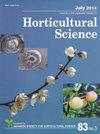Inhibition of Viviparous Sprouting on Melon Seeds Using High Level of Potassium Fertilization or Abscisic Acid Application
Journal of The Japanese Society for Horticultural Science
Pub Date : 2013-07-01
DOI:10.2503/JJSHS1.82.227
引用次数: 1
Abstract
The present experiments were undertaken in order to clarify the effects of a high potassium fertilization level on the occurrence of viviparous sprouting in melon fruit. Melon (Cucumis melo L. group) plants of two susceptible lines and one resistant line to viviparous sprouting were used at two different potassium concentrations. A high potassium fertilization level (12.0 mmol·L) resulted in a marked decrease of the occurrence of viviparous sprouting in the susceptible lines, and in the increase of the endogenous ABA content. No significant differences were observed in the seed number per fruit, the seed weight, and the percentage of seed germination at a high level of potassium fertilization. Further experiments were conducted in order to analyze the effects of exogenous ABA treatment at a low potassium fertilization level (1.5 mmol·L) on the occurrence of viviparous sprouting in melon fruit. At 25 days after pollination, ABA solution at different concentrations was sprayed on the fruits of the susceptible melon line grown at two different potassium fertilization levels. Even at a low potassium fertilization level, exogenous ABA application inhibited the occurrence of viviparous sprouting and increased ABA contents both in juice samples around the placenta and in the seeds. ABA treatment, however, led to a significant decrease in the seed number per fruit and in the percentage of seed germination, as a result of a marked increase in the ABA content and potassium absorption.高施钾和脱落酸对甜瓜胎生发芽的抑制作用
本试验旨在阐明高施钾水平对甜瓜果实胎生芽发生的影响。以甜瓜(Cucumis melo L. group) 2个胎生发芽敏感品系和1个抗性品系的植株为试验材料,在2种不同钾浓度下进行试验。高施钾水平(12.0 mmol·L)显著降低了敏感品系的胎生出芽率,提高了内源ABA含量。高钾处理对单果种子数、种子重和种子发芽率无显著影响。为了进一步分析低钾水平(1.5 mmol·L)外源ABA处理对甜瓜果实胎生发芽的影响。授粉后25 d,将不同浓度的ABA溶液喷施在2个不同施钾水平的敏感品系的果实上。即使在低钾施肥水平下,外源ABA的施用也抑制了胎生发芽的发生,并增加了胎盘周围汁液样品和种子中ABA的含量。ABA处理显著提高了果实中ABA的含量和钾的吸收量,显著降低了单果种子数和种子发芽率。
本文章由计算机程序翻译,如有差异,请以英文原文为准。
求助全文
约1分钟内获得全文
求助全文
来源期刊
自引率
0.00%
发文量
0
审稿时长
>36 weeks

 求助内容:
求助内容: 应助结果提醒方式:
应助结果提醒方式:


